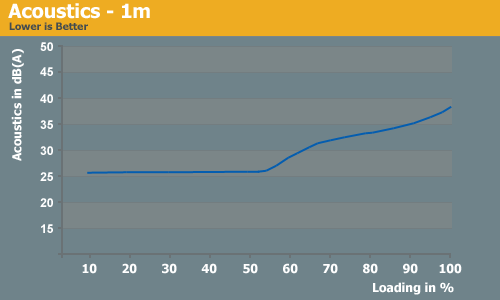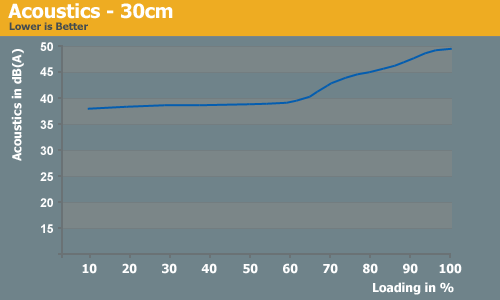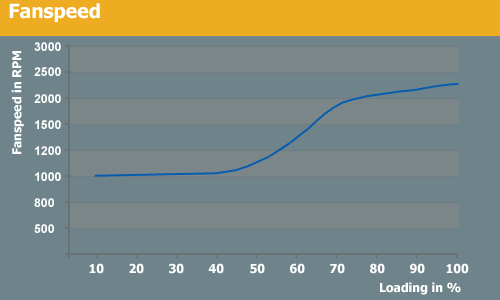The Single 12V Rail SilverStone Olympia OP650
by Christoph Katzer on July 13, 2007 12:00 PM EST- Posted in
- Cases/Cooling/PSUs
Acoustics
The fan control does a good job on this model. The fan is rotating with a minimum speed with up to a 50% load on the power supply. This means you can put a little more than 300 watts load on it before you will experience an increase in PSU noise. The tests re conducted in a special room which isolates the power supply from the noisy Chroma. In this way we can get accurate measurements of the power supply only. The microphone is measuring in two different loacations. The first one is around 30cm far from the backside of the power supply and the second measurement is being taken from 1m distance. The ambient-noise is minimized through the 5-layer thick wall containing different isolating materials.
Running in an average system, the measured 26 dB(A) would not be the loudest thing to worry about and wouldn't significantly contribute to the overall SPL of the system. If running with more than 60% the fan will constantly spin faster and reach up to 38 dB(A) noise which is still an acceptable result for most PCs but not really calm anymore.
From a subjective point of view the noise is not too loud either. The power supply didn't produce any noise other than from the fan which can be quite bothersome from time to time. There is no ticking noise from the fan either.



The fan control does a good job on this model. The fan is rotating with a minimum speed with up to a 50% load on the power supply. This means you can put a little more than 300 watts load on it before you will experience an increase in PSU noise. The tests re conducted in a special room which isolates the power supply from the noisy Chroma. In this way we can get accurate measurements of the power supply only. The microphone is measuring in two different loacations. The first one is around 30cm far from the backside of the power supply and the second measurement is being taken from 1m distance. The ambient-noise is minimized through the 5-layer thick wall containing different isolating materials.
Running in an average system, the measured 26 dB(A) would not be the loudest thing to worry about and wouldn't significantly contribute to the overall SPL of the system. If running with more than 60% the fan will constantly spin faster and reach up to 38 dB(A) noise which is still an acceptable result for most PCs but not really calm anymore.
From a subjective point of view the noise is not too loud either. The power supply didn't produce any noise other than from the fan which can be quite bothersome from time to time. There is no ticking noise from the fan either.













46 Comments
View All Comments
meeshu - Thursday, July 19, 2007 - link
I would have liked to have seen results of ripple tests, regardless of whether they are within spec or not.Piyono - Sunday, July 15, 2007 - link
As your power supply testing methodology continues to evolve do you see yourself retesting previously reviewed units, if necessary? My concern is that all test results should be directly comparable between all reviewed units.Thanks,
Piyono
Christoph Katzer - Monday, July 16, 2007 - link
If it's possible (a matter of time) we will do it.Piyono - Sunday, July 15, 2007 - link
Very good first PS review.As an audio guy I feel it's necessary to point out that the *frequency* of the sound generated by a fan has a lot to do with how loud / annoying we might perceive it to be. The human ear, as we know, is not linear and is more sensitive at some frequencies than at others (for those unfamiliar with the concept, Google "Fletcher Munson equal loudness curve" or try the [url=http://en.wikipedia.org/wiki/Fletcher-Munson_curve...">http://en.wikipedia.org/wiki/Fletcher-Munson_curve...]Wikipedia entry[/url]).
For example, given two fans outputting 40dBSPL, one generating a tone centered at 1KHz will be far more annoying than one with a fundamental of 600Hz, simply because the ear is particularly sensitive around 1KHz, and less so at 600Hz.
Given the quality of your audio test equipment (great choice on the MG mic & pre, BTW) you can easily create an accurate frequency plot of the PS's audio output. Perhaps you could include these frequency plots in future reviews, along with sample recordings of the actual fan noise.
Just a thought.
I've been waiting a long time for a review site to pick up some chroma gear and put out consistent PS reviews. Kudos!
Piyono
mindless1 - Wednesday, July 18, 2007 - link
It can be problematic picking a high wattage PSU based on fan noise frequency. It is actually better to have a higher fan frequency for PSU lifespan, because that higher frequency is typically caused by use of ball bearings instead of sleeve bearing, which is much more reliable in a horizontally mounted PSU fan.If the noise is important I suggest you use a system that doesn't consume much power and has the older rearward facing fan (being a quality sleeve bearing, brand like Papst or Panaflo).
Christoph Katzer - Sunday, July 15, 2007 - link
Thanks, actually we are still working on the audio-equipment. When it's ready we will have quite some data to show.Piyono - Sunday, July 15, 2007 - link
Hey, that's good to know.I'm eager to see how this develops!
Piyono
xsilver - Saturday, July 14, 2007 - link
do silverstone manufacture this psu themselves or do they subcontract it to an OEM company like etasis?im most intrigued because they make the ZF series of psu's which have a dual PCB design
http://www.xbitlabs.com/articles/other/display/atx...">http://www.xbitlabs.com/articles/other/display/atx...
this review tells of how this is one of the very few psu's to actually have true independent voltage regulation; not sure how that has any real world effect but it at least looks like one of the most jam packed psu's i've ever seen.
Operandi - Saturday, July 14, 2007 - link
A good PSU review the proper way isn't an easy thing but it looks like you guys have an excellent handle on it, great work.maluckey - Saturday, July 14, 2007 - link
I noticed that the secondary heatsink temperature reached 90 degrees during testing. I've never been a fan of Teapo capacitors, and I suspect (though not stated in the article) that the caps on this PSU are NOT 105 C. caps. This means that given time, the degradation can be significant and the MTBF will rise accordingly. Can anyone justify 170 doolars a new PSU every couple of years? Especially when 35 dollars in better caps would change all that. It would basically future-proof your purchase, though the manufacturer would have to raise the price accordingly as they are not in the business of charity.I forsee this happening as soon as the majority of home users expect more from a PSU than a shiny case or blinky lights and a wildly opptimistic output rating.